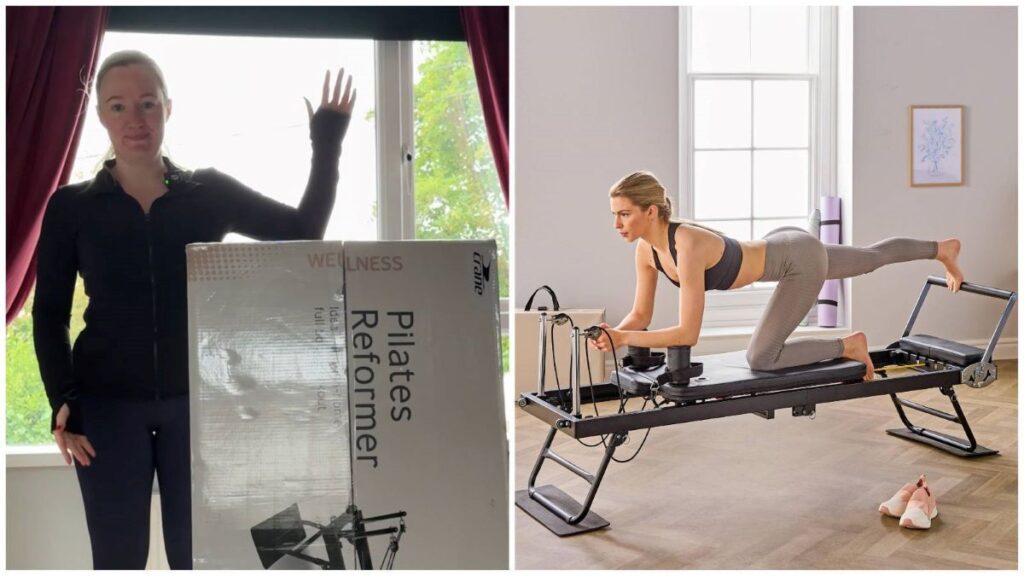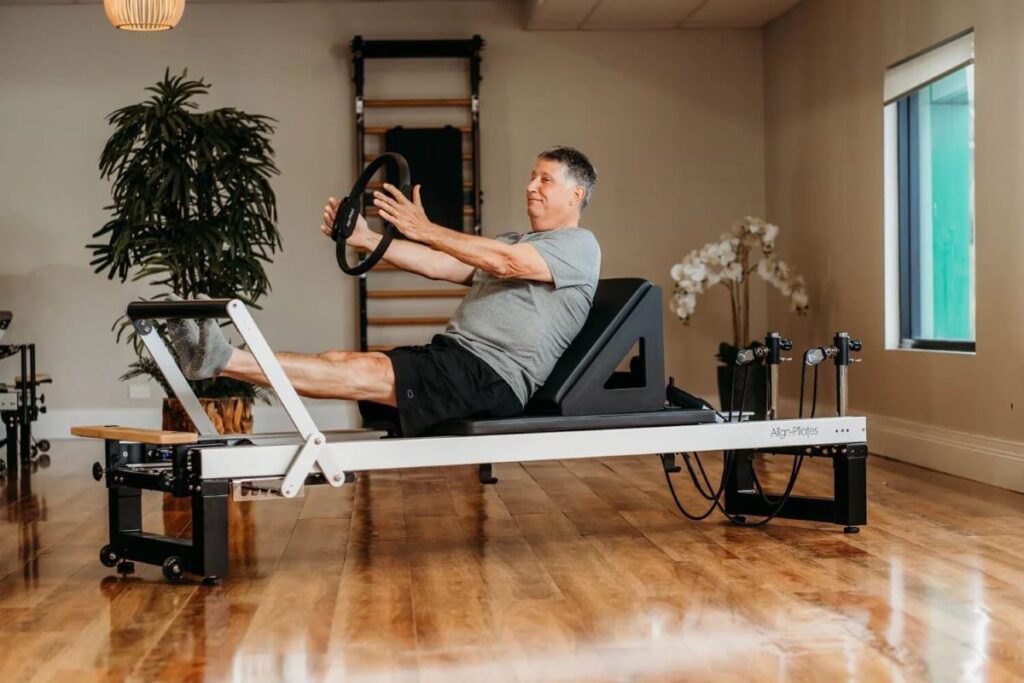Understanding Pilates Reformers
Pilates reformers are versatile pieces of equipment designed to enhance the practice of Pilates, offering a range of exercises that target various muscle groups. They utilise springs, pulleys, and a sliding carriage to provide resistance, allowing users to perform both strength training and flexibility exercises. The two main types of reformers available on the market are the compact Pilates reformer and the traditional Pilates reformer. Each has its unique features and benefits, making the choice between them an important consideration for potential buyers.
What is a Compact Pilates Reformer?
A compact Pilates reformer is designed with space-saving features, making it ideal for home use or smaller studios. These reformers typically have a more streamlined design, often folding or being easily stored away when not in use. Despite their smaller size, they still offer a range of exercises and resistance options, making them a popular choice for those who may not have the luxury of a dedicated workout space.
Benefits of Compact Reformers
One of the primary advantages of compact reformers is their portability. Many models can be easily transported, allowing users to take their workout anywhere. Additionally, compact reformers often come with adjustable features, enabling users to modify the resistance and height to suit their individual needs. This adaptability makes them suitable for beginners and advanced practitioners alike.
Moreover, compact reformers often feature a variety of attachments, such as straps and bars, which can enhance the versatility of workouts. Users can perform an extensive range of exercises, from leg presses to arm pulls, all while engaging their core and improving overall body alignment. This versatility is particularly beneficial for those recovering from injuries, as it allows for low-impact, controlled movements that can aid in rehabilitation. Furthermore, many compact reformers are designed with user-friendly interfaces, making them accessible for individuals of all fitness levels, including those new to Pilates.
In addition to their practical benefits, compact reformers can also contribute to a more engaging workout experience. With the ability to easily switch between exercises and modify resistance, users can create dynamic routines that keep their sessions fresh and motivating. This adaptability encourages consistency in practice, which is essential for achieving fitness goals. As Pilates continues to grow in popularity, the compact reformer stands out as an excellent investment for anyone looking to incorporate this effective form of exercise into their daily routine.
Exploring Traditional Pilates Reformers
Traditional Pilates reformers are typically larger and more robust, designed for commercial studios or dedicated home gyms. These reformers often feature a heavier frame, providing greater stability during exercises. They may also include additional components, such as a jump board or extra springs, allowing for a wider variety of workouts.
Advantages of Traditional Reformers
One of the key benefits of traditional reformers is their durability. Built to withstand frequent use, they are often favoured by professional studios. The larger size also allows for more complex exercises, making them suitable for advanced practitioners. Furthermore, traditional reformers often come with a variety of attachments and accessories, enhancing the workout experience.
Considerations for Traditional Reformers
While traditional reformers offer many advantages, they also come with some drawbacks. Their size and weight can make them less suitable for home use, particularly in smaller living spaces. Additionally, they tend to be more expensive than their compact counterparts, which can be a significant factor for those on a budget.
Key Differences Between Compact and Traditional Reformers
When deciding between a compact and traditional Pilates reformer, it is essential to consider several key differences that may influence your choice. These differences include size, price, versatility, and intended use.
Size and Space Considerations
Size is one of the most significant differences between compact and traditional reformers. Compact reformers are designed to save space, making them ideal for smaller homes or studios. They can often be folded or stored away, allowing for greater flexibility in usage. On the other hand, traditional reformers require more space and are typically a permanent fixture in a workout area.
Price Comparison
Price is another crucial factor when choosing between the two types of reformers. Compact reformers are generally more affordable, making them accessible for individuals or small studios with limited budgets. Traditional reformers, while often more expensive, offer a higher level of durability and versatility, which may justify the investment for serious practitioners or commercial settings.

Versatility and Functionality
In terms of versatility, traditional reformers usually offer a wider range of exercises and attachments. This can be particularly beneficial for advanced users looking to challenge themselves with more complex movements. Compact reformers, while still versatile, may have limitations in terms of the types of exercises that can be performed, which could be a consideration for those seeking a comprehensive workout.
Who Should Choose a Compact Pilates Reformer?
Compact Pilates reformers are ideal for individuals who have limited space but still want to incorporate Pilates into their fitness routine. They are particularly well-suited for beginners who may be exploring Pilates for the first time. The affordability and portability of compact reformers make them an attractive option for those who want to practice at home without a significant financial commitment.
Perfect for Small Spaces
For those living in apartments or smaller homes, a compact reformer can easily fit into a corner or be stored under a bed. This convenience allows users to maintain their workout routine without the need for a dedicated gym space. Additionally, the ability to fold and store the reformer means it can be easily put away when not in use, keeping living areas uncluttered.
Great for Beginners
Beginners can benefit from the simplicity and ease of use that compact reformers offer. Many models come with instructional materials or online resources to help new users learn the basics of Pilates. This supportive environment can encourage individuals to develop their skills and confidence before progressing to more advanced equipment.
See Also : What Makes a Reformer Pilates Bed Different from a Traditional Reformer?
Who Should Choose a Traditional Pilates Reformer?
Traditional Pilates reformers are best suited for serious practitioners or those who plan to use the equipment frequently. They are ideal for individuals who have a dedicated workout space and are looking for a more comprehensive Pilates experience. Additionally, studios or fitness centres that offer Pilates classes may find traditional reformers to be a worthwhile investment due to their durability and versatility.
For Serious Practitioners
For those who are committed to their Pilates practice, traditional reformers provide the stability and range of exercises needed to challenge and develop strength. The additional features and attachments available with traditional reformers allow users to explore a wider variety of movements, catering to their evolving fitness needs.
Commercial Use
For studios or fitness centres, investing in traditional reformers can enhance the quality of classes offered. The durability and robust design of these reformers ensure they can withstand the rigours of frequent use by multiple clients. Furthermore, the versatility of traditional reformers allows instructors to create diverse and engaging classes, attracting a broader clientele.
Making the Right Choice for You
Ultimately, the decision between a compact and traditional Pilates reformer comes down to individual needs, preferences, and circumstances. It is essential to assess factors such as available space, budget, and fitness goals before making a purchase. Both types of reformers have their unique benefits, and understanding these can help inform your decision. Visit https://www.healthdirect.gov.au/health-benefits-of-yoga-and-pilates to get more about the health benefits of Pilates and yoga.
Assessing Your Space
Before investing in a reformer, consider the space available in your home or studio. If space is limited, a compact reformer may be the best option. Conversely, if you have ample room and are serious about your Pilates practice, a traditional reformer could be a worthwhile investment.
Budget Considerations
Budget is another critical factor to consider. Compact reformers are generally more affordable, making them accessible for those on a tighter budget. However, if finances allow, investing in a traditional reformer may provide long-term benefits in terms of durability and versatility.

Conclusion
Choosing between a compact Pilates reformer and a traditional reformer ultimately depends on individual preferences and circumstances. Both types of reformers offer unique advantages, catering to different needs and fitness goals. By carefully considering factors such as space, budget, and intended use, individuals can make an informed decision that best suits their Pilates journey.
Whether opting for the space-saving compact reformer or the robust traditional reformer, both options provide an excellent way to enhance strength, flexibility, and overall well-being through Pilates. The right choice will empower individuals to enjoy their practice and achieve their fitness aspirations.